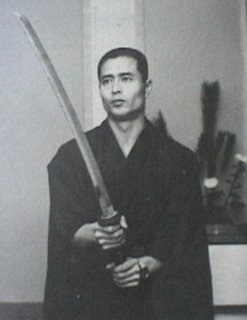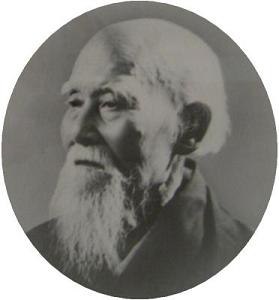more baseball & aikido, Oh and Osensei
Sometimes a book becomes a real friend. You wind up taking it with you to lunch or late dinner, and while you eat you browse, search, and immerse. Such a book for me recently is "A Zen Way of Baseball" by Sadaharu Oh. As has been mentioned in a previous blog, Oh holds the absolute record for career home runs with 868, topping Aaron, Bonds, and Ruth. The book is currently out of print, but was purchased for me online by Seth Spitzer. Thank you.

Even though the title emphasizes Zen, it could very well have been "An Aikido Way of Baseball". Both Oh and his hitting coach, Hiroshi Arakawa, met with and had a personal relationship with Aikido's founder, Morihei Ueshiba. They incorporated such Aikido concepts as center, extension, focus into their training together. Oh was not allowed to get on the mat, his baseball employers fearing that it might be to dangerous. His coach,instead, trained at Tokyo's Aikido Hombu Dojo in the 1960's and even consulted with Ueshiba Osensei on his protegee's problems.
Oh initially describes himself as a young hitter gifted with good eyes and quick hands. His fatal flaw is that he had a hitch in his swing. Just as his bat should have been going forward to meet the oncoming pitch, he would automatically drag it backward. While his gifts allowed him to hit outside pitching, increasingly pitchers found it easy to confound him with off-speed deliveries and by pitching inside. One practice his coach used to teach him center was to have him stand on one leg while holding a bat. Oh got so strong in this position that an 8 year old child could hang onto his arm and not disturb his balance. It was labeled the "flamingo' style of hitting.

One game Oh is ordered by his coach to incorporate this in a game, to stand on one leg while waiting for the ball. Oh finds that standing on one leg somehow eliminates his fatal hitch, and he begins to become an outstanding power hitter. Much of the book is the quest by both Oh and his coach to delve into the true meaning of what it means to stand on one leg.
Osensei is a very important character in this book. Oh learns that true balance comes from the center point(2 inches below the navel) and that power is generated by being able to extend outward from this point. Oh learns, as do aikido students, that strength, both yours and your partner's, follows the flow of ki. And this in turn must flow from the center point. Osensei counsels Oh's coach to teach him to actively wait, that balance from the center has not only a physical and mental component, but a spiritual one as well. One day while observing Osensei, Oh asks the question;"How could I begin to do in a batter's box what Ueshiba sensei did in the middle of the dojo floor?"
Much of the rest of the book is Oh's quest to master himself through mastering the art of hitting a baseball. Osensei advises Oh that ma(interval or separation) exists for him only because an opponent, in Oh's case the pitcher, exists. He counsels Oh that he must remove the ideal that he and the pitcher separately exists, that when Oh acheives a unity with what before was an opponent, he will know what the pitcher will do before the pitcher does. These are very much Aikido concepts, though their execution is not easy. Oh also takes up the discipline of the Japanese sword, giving in fascinatint detail the similarity between a home run swing and the cutting motion of a Japanese samurai blade.
One of the main tenets of the book is that Baseball is an American game brought into the Japanese culture. Oh's devotion to his coach, his respect, and his ultimate teachability are very much traditional Japanese values, and would be unusual to find in this culture. But Oh brought to everything an individuality, a willingness to extend himself way past the cultural norm(even in Japan)that is unique. Towards the end of the book Oh builds a simple tatami room in his house like the one in his coaches house. And he hopes that one day a young pupil will come to him as he did to Arakawa to be taught. No one ever comes.......Arakawa himself tells Oh that Oh is too frightening to attract any pupil, that the one legged or "flamingo style" of batting lasted not only in Oh's generation, but only with Oh himself.
I remember in about 1970 the Willie Mays led SF Giants did some spring training in Japan. Over satellite a game between the SF Giants and the Yomiuri Giants was telecast in the bay area. Lon Simmons quipped that whatever the outcome of the game, that the "Giants" would be winners. I remember that Willie Mays had a double and that the game was tied going into the later innings. The Giants had a top closer named Frank Linzy, who threw a very heavy sinker ball. Oh won the game late with a home run off Linzy. Quite a memory from almost 40 years ago about a legend.....

Even though the title emphasizes Zen, it could very well have been "An Aikido Way of Baseball". Both Oh and his hitting coach, Hiroshi Arakawa, met with and had a personal relationship with Aikido's founder, Morihei Ueshiba. They incorporated such Aikido concepts as center, extension, focus into their training together. Oh was not allowed to get on the mat, his baseball employers fearing that it might be to dangerous. His coach,instead, trained at Tokyo's Aikido Hombu Dojo in the 1960's and even consulted with Ueshiba Osensei on his protegee's problems.
Oh initially describes himself as a young hitter gifted with good eyes and quick hands. His fatal flaw is that he had a hitch in his swing. Just as his bat should have been going forward to meet the oncoming pitch, he would automatically drag it backward. While his gifts allowed him to hit outside pitching, increasingly pitchers found it easy to confound him with off-speed deliveries and by pitching inside. One practice his coach used to teach him center was to have him stand on one leg while holding a bat. Oh got so strong in this position that an 8 year old child could hang onto his arm and not disturb his balance. It was labeled the "flamingo' style of hitting.

One game Oh is ordered by his coach to incorporate this in a game, to stand on one leg while waiting for the ball. Oh finds that standing on one leg somehow eliminates his fatal hitch, and he begins to become an outstanding power hitter. Much of the book is the quest by both Oh and his coach to delve into the true meaning of what it means to stand on one leg.
Osensei is a very important character in this book. Oh learns that true balance comes from the center point(2 inches below the navel) and that power is generated by being able to extend outward from this point. Oh learns, as do aikido students, that strength, both yours and your partner's, follows the flow of ki. And this in turn must flow from the center point. Osensei counsels Oh's coach to teach him to actively wait, that balance from the center has not only a physical and mental component, but a spiritual one as well. One day while observing Osensei, Oh asks the question;"How could I begin to do in a batter's box what Ueshiba sensei did in the middle of the dojo floor?"
Much of the rest of the book is Oh's quest to master himself through mastering the art of hitting a baseball. Osensei advises Oh that ma(interval or separation) exists for him only because an opponent, in Oh's case the pitcher, exists. He counsels Oh that he must remove the ideal that he and the pitcher separately exists, that when Oh acheives a unity with what before was an opponent, he will know what the pitcher will do before the pitcher does. These are very much Aikido concepts, though their execution is not easy. Oh also takes up the discipline of the Japanese sword, giving in fascinatint detail the similarity between a home run swing and the cutting motion of a Japanese samurai blade.
One of the main tenets of the book is that Baseball is an American game brought into the Japanese culture. Oh's devotion to his coach, his respect, and his ultimate teachability are very much traditional Japanese values, and would be unusual to find in this culture. But Oh brought to everything an individuality, a willingness to extend himself way past the cultural norm(even in Japan)that is unique. Towards the end of the book Oh builds a simple tatami room in his house like the one in his coaches house. And he hopes that one day a young pupil will come to him as he did to Arakawa to be taught. No one ever comes.......Arakawa himself tells Oh that Oh is too frightening to attract any pupil, that the one legged or "flamingo style" of batting lasted not only in Oh's generation, but only with Oh himself.
I remember in about 1970 the Willie Mays led SF Giants did some spring training in Japan. Over satellite a game between the SF Giants and the Yomiuri Giants was telecast in the bay area. Lon Simmons quipped that whatever the outcome of the game, that the "Giants" would be winners. I remember that Willie Mays had a double and that the game was tied going into the later innings. The Giants had a top closer named Frank Linzy, who threw a very heavy sinker ball. Oh won the game late with a home run off Linzy. Quite a memory from almost 40 years ago about a legend.....


0 Comments:
Post a Comment
<< Home